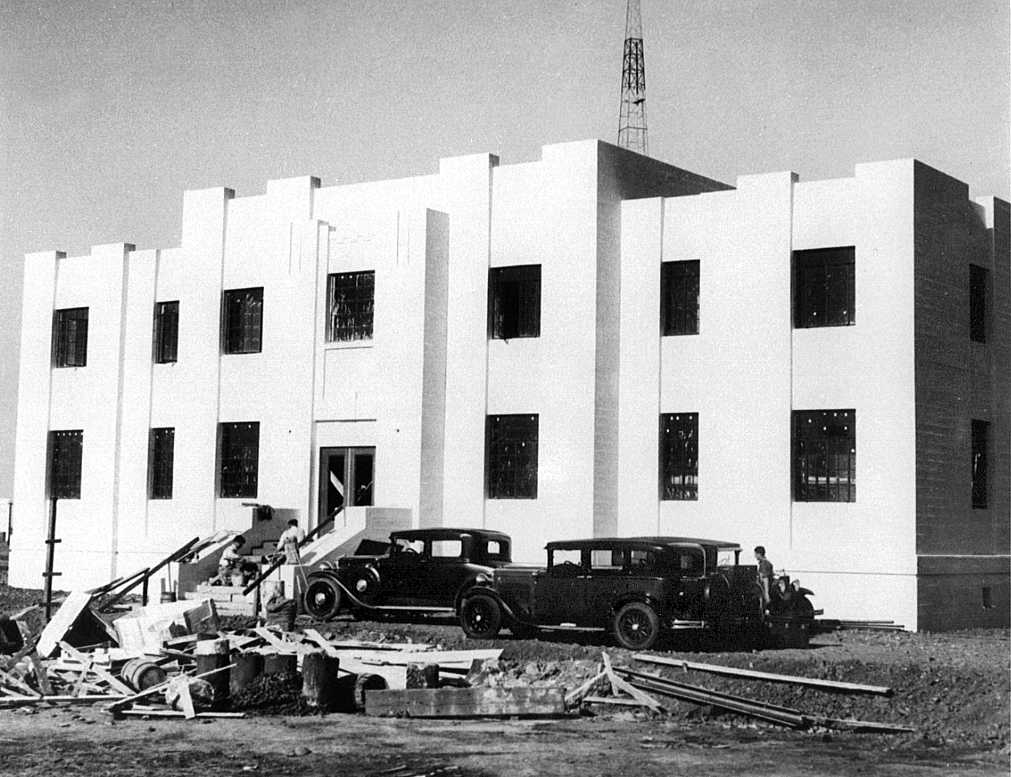
A Visit to the KNBC Belmont
AM Transmitter in the 1950s
By Fred Krock
What was it like to work at KNBC in the 1950s? All the people who could tell us are gone now. The story must be second hand. As an eager young 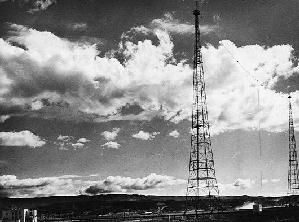 broadcaster I would visit the NBC Belmont transmitter occasionally to listen to the old timers talk about the good old days. I think we all realized even then that the golden days of radio were behind us.
broadcaster I would visit the NBC Belmont transmitter occasionally to listen to the old timers talk about the good old days. I think we all realized even then that the golden days of radio were behind us.
I worked at a broadcast transmitter about fifteen minutes drive from the KNBC transmitter. Sometimes when I didn’t feel like going home after signing off the station at midnight, I would go hang out at the KNBC transmitter for a while. I knew almost all of the San Francisco NBC engineers. We were members of the same union, NABET. We knew each other from union meetings and from walking the picket line together.
This is an oral history, with all the shortcomings of human memory. These are my recollections of conversations which happened over forty years ago. I never dreamed that today I would be writing about those events. I made no notes. I never checked the accuracy of what I was told. So, with that disclaimer, here goes.
The KNBC Transmitter
The original call letters of KNBC were KPO. They were changed to KNBC in 1947. Later they were changed to KNBR when NBC wanted to use the KNBC call letters for a television station in Los Angeles.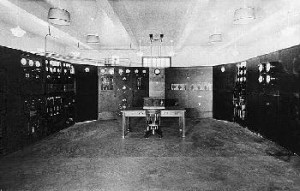
The 50 kilowatt 680 kHz AM transmitter in Belmont was built for NBC by General Electric in 1932. It was installed in a building custom-built for this transmitter.
Later NBC made a rule that all equipment used by the company must be made by RCA. To comply, the KNBC GE transmitter had been converted into an RCA transmitter. It was painted RCA umber gray (actually a brown color). RCA obtained FCC type approval for this transmitter. RCA supplied a new name plate, giving an RCA model number which replaced the GE name plate. All traces of the GE name were obliterated.
That old GE transmitter used a lot of electricity. The 5 kW driver and the 50 kW final stage were linear amplifiers which were very inefficient. An engineering study in 1952 showed that a new transmitter would pay for itself in under two years from savings on power bills alone. NBC continued to use the old transmitter in spite of this showing.
Today we can only speculate on why that old GE transmitter was not replaced. Possible reasons were:
- NBC was spending almost its entire capital budget on television.
- The ampliphase transmitter was under development by RCA, so NBC was waiting until it was available.
-
Television and FM broadcasting were expected to replace AM in a few years so it didn’t make sense to replace a transmitter for a short time.

By the 1950s the GE transmitter final amplifier tubes were used only by NBC owned stations. Replacements were hand-made by the RCA transmitting tube factory at great expense. These tubes were reported to last for a long time. I was told that typical tube life was over five years, which was not unusual for bright tungsten filament tubes.
The water cooled final tubes were so big and heavy that a small crane on wheels was needed to remove them from their sockets in the transmitter.
KNBC engineers kept accurate records of all tubes in use, even receiving-type tubes used in audio amplifiers. They calculated the average life for every tube used at the Belmont transmitter. After an average life figure was determined, tubes were replaced automatically before they reached that age even though they showed no signs of failure. High power transmitter tubes were run until they showed reduced emission before they were replaced. These tubes very rarely had sudden total failures.
The Facility
The transmitter literally was built into the building. The plate transformer, switch gear, water pumps, and motor generator sets for filament and bias voltages were on the ground floor. A well equipped machine shop and parking garage also were on the ground floor.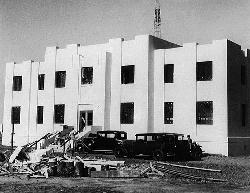
From the front door you walked up a grand staircase to the second floor where the transmitter was located. The transmitter was arranged in a ” U” shape with a control console in the center of the floor. I never saw anyone sitting there. Operators usually were in an adjoining room with racks of audio equipment, monitoring equipment, a desk, and log-keeping typewriters. I believe the transmitter also could be controlled from this desk.
Access to the rear of the transmitter was through interlocked doors on both sides of the transmitter. Many of the transmitter racks had no rear walls or doors. Once you walked through an access door, you were inside the transmitter.
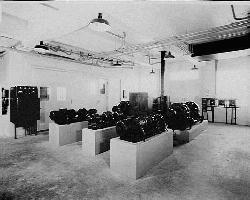 Transmitting tubes used at KNBC required DC voltage on the filaments to reduce hum. Motor generators were the best way to get low-voltage high-current DC for the filaments. I never understood why bias voltage also came from motor generators because the voltage was not very high and the current was almost zero. I believe the bias motor generators were replaced with conventional tube rectifiers in the 1950s to reduce maintenance expense of mechanical devices.
Transmitting tubes used at KNBC required DC voltage on the filaments to reduce hum. Motor generators were the best way to get low-voltage high-current DC for the filaments. I never understood why bias voltage also came from motor generators because the voltage was not very high and the current was almost zero. I believe the bias motor generators were replaced with conventional tube rectifiers in the 1950s to reduce maintenance expense of mechanical devices.
The transmitter had two independent sets of motor generators. One motor generator could be out of service for repairs while the other one was on the air. Even after the bias generators no longer were used, they were kept in serviceable condition in case of an emergency.
A pond of cooling water was out back. My understanding was that the cooling pond was not used. The only source of water was a well that gave very brackish water. Distilled water cooled the tube anodes. Then it went through a heat exchanger or radiator to cool it. The well water was so hard that it gave serious problems with mineral deposits in the heat exchangers so the air-cooled radiators were used. Bottled water was supplied for drinking and making coffee.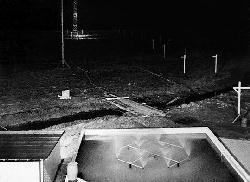
The original antenna was replaced in the late 1940’s with a Franklin antenna. It lowered the vertical angle of radiation. This antenna increased ground wave radiation at the expense of skywave radiation. I was told that with the old antenna KPO could be heard in Hawaii and on the West Coast like a local station at night. The new antenna reduced distant listening while it improved the nighttime signal in the far suburbs of the Bay Area.
The “Secret” GE Limiter
KNBC always sounded good on the air. The modulation monitor showed almost no negative carrier shift with modulation. Stations were limited to 100% positive peak modulation by the FCC in those days. How that GE transmitter would have performed after the FCC relaxed positive peak limits is a good question.
A new GE audio peak limiter was used on the air. It, too, was repainted RCA umber gray. The original GE silk-screen lettering had been reproduced painstakingly with decals. A small metal RCA emblem was screwed to the front panel.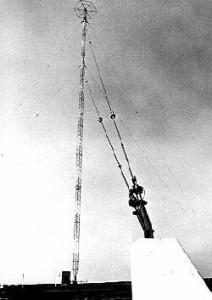
The GE peak limiter was by far the best on the market. It was the only new equipment that the tightwad owner of the station where I worked ever bought. It cost about three times as much as other brands. (The RCA sold for about $600.)
Most peak limiters sampled audio level at the output stage, thus sudden peaks could escape before the level could be turned down. The GE limiter sampled audio level at the input. Then it put the audio through a delay line before it reached a variable gain stage. Since the variable gain was adjusted before a peak got there, absolutely no peaks escaped to cause overmodulation. Stations using this limiter sounded louder and cleaner than stations using any other brand.
I never found out how this GE limiter came to be used at KNBC. I heard rumors that all the NBC owned and operated radio stations were using GE limiters but I never verified this. The disguise was so well done that it took a broadcast engineer familiar with the device to recognize a GE product. No station manager or non-technical manager would have been aware of the deception.
Programs were fed from the studio to the transmitter on an 8 kHz leased telephone line. It rarely gave any trouble. An FM receiver allowed rebroadcasting signals from KNBC-FM in case of phone line problems.
KNBC had a Morse code line between the Belmont transmitter and master control in San Francisco Radio City. Almost all the transmitter engineers could send and receive code. This Morse line was very cheap to lease from the telephone company. The reason, I was told, was that AT&T had no desire to have to go into the telegraph business even though the second “T” in its name stood for “Telegraph”. Thus, AT&T subsidized Western Union to help keep it in business by leasing Morse lines at very low rates.
At most radio stations, announcers kept the official FCC program log. At KNBC, one of the transmitter engineers kept the program log. Announcers worked from a program schedule. The official log was typed by one of the engineers on an old office typewriter. A copy of the program schedule was available for reference. Any late schedule changes were sent on the Morse line.
If it sounded like a commercial, the transmitter engineer entered it into the log even though it might not be on the schedule. This helped keep payola and plugola off the air. Announcers had a lot of explaining to do if what sounded like an unscheduled commercial turned up on a log of their shift.
The Engineering Staff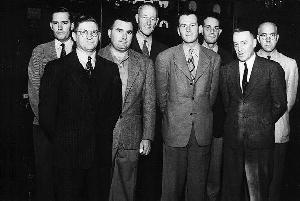
Two operators were on duty at Belmont twenty-four hours a day, seven days a week. FCC rules did not allow remote control of a 50 kW AM transmitter at that time.
Work shifts were 8 AM to 4 PM, 4 PM to midnight, and midnight to 8 AM. Operators worked shifts which rotated weekly. An operator would work five days on the 8 AM shift, then after two days off he would work on the 4 PM shift and then the following week on the midnight shift. The KNBC-FM transmitter on San Bruno Mountain had only one operator on duty and only when it was on the air.
Two operators were on duty to minimize down time in case of a transmitter failure. Union rules and common sense prevented an operator from working inside an interlocked compartment without another experienced person present. Many repairs on that big old transmitter physically required two people. In case of equipment failure, repairs could start at once without having to wait for another person to arrive at the transmitter.
In those days few radio stations had auxiliary or backup transmitters. Operators were expected to get the station back on the air quickly in case of equipment failure. KNBC did not get a backup transmitter until some time in the 1960’s when Civil Defense authorities bought a ten kilowatt AM transmitter for the purpose.
Over half of the Belmont transmitter operators had worked as shipboard radio operators at one time or another. They had gotten tired of going to sea, so they got jobs at broadcast transmitters. A few of them would take a leave of absence occasionally and ship out for a trip or two. Most of the rest had amateur radio operator licenses. One of the operators was a licensed dentist. He preferred working at a transmitter to looking in mouths, so he had given up his practice.
The transmitter and the building always were immaculate. Floors were polished. The inside of the transmitter looked as if it had just come from the factory. This may have come from the seagoing heritage of many of the operators.
Old timers did not refer to their employer as NBC. It was always “THE NBC”. They would say something like, “I have worked for THE NBC eighteen years now.”
Most of the transmitter operators had high seniority, so were not affected by the NBC radio engineering layoffs which began in 1952. Until the NBC Pacific Network was shut down in 1952, fifty-two men were employed in San Francisco by NBC Radio as engineers. After that, it was all downhill. When the station moved out of San Francisco Radio City in 1967, only twenty-three engineers were employed.
Some low seniority San Francisco NBC engineers were allowed to transfer to Los Angeles where NBC was hiring engineers for television. Others transferred to the NBC international short-wave station at Dixon, California, about seventy miles northeast of San Francisco, where they bumped even lower seniority men. The Dixon station was on the same seniority list as San Francisco. Dixon engineers always complained about having to drive to San Francisco for union meetings.
The short-wave station was leased to the Voice of America, but operated by NBC. Later it was sold to VOA, and the former NBC engineers there became civil servants.
In the 1950s KNBC broadcast a one kHz tone at about 30% modulation level as part of the Conelrad Civil Defense alerting system between about 2 AM and 5 AM, while no regular programs were broadcast. Every half hour, a transmitter operator would play a transcribed station identification. Special dispensation had been obtained from AFTRA, the announcer’s union, to allow the station to broadcast without a staff announcer on duty.
Post Script
Today, radio transmitters are operated by remote control from the studio by announcers, or are operated automatically. Studio engineers are unknown. One or two engineers are responsible for maintaining as many as four or five different radio stations, all owned by the same company. The broadcast industry is very different from the days when two men were on duty twenty-four hours a day at the KNBC transmitter in Belmont.
Copyright © 1998 Fred Krock. All rights reserved. Reprinted with permission.
![]()

